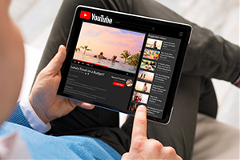YouTube has been around for 15+ years and is the undisputed king of online video content. Even before the global pandemic, YouTube was the place people went to find video content on just about any topic you can imagine. During the pandemic, watching and creating videos became a popular activity while people stayed at home and sought entertainment. YouTube also provided a platform for connecting people virtually. 
For some years now, video has been the most engaging form of online and digital content. Brands have learned to use this platform (as well as other video platforms) to reach and engage with an audience. If you’re not using YouTube for marketing, here are some reasons to consider doing so.
- Creating brand awareness. A Google study from 2018 found that video content consumers are four times more likely to use YouTube to find information about brands, products and services, and are two times more likely to purchase an item they saw on YouTube.
- Organic reach. Did you know that YouTube is a search engine, ranking second only to Google as a search site? By optimizing titles, descriptions and keywords, your content can rank higher in search results. And since videos can get top placement in Google search results, you can increase traffic without paying for it. You should also use tags, post content on a consistent basis, creating content that’s valuable to your audience and inviting guests into your videos to help increase your reach.
There is an almost endless list of types of video content you can use:
- Tutorials
- Behind the scenes
- Product or service videos
- Listicles - lists are popular and it’s easy to create video content from list items
- Q&A, especially with subject matter experts
Before you start creating videos for YouTube, you should understand the platform’s specs.
- Length. In general, users can upload videos that are up to 15 minutes long. Those with verified accounts can upload longer videos.
- Format. YouTube supports these formats:
- MP4 with H. 264 vodeo codec and AAC audio codec (preferred)
- .MOV
- .MPEG4
- .AVI
- .WMV
- .MPEGPS
- .FLV
- 3GPP
- WebM
- DNxHR
- ProRes
- CineForm
- HEVC (hs65)
- Resolution. Size and aspect ratio for elements:
- Channel art banner: 2650 x `440 pixels
- Profile picture: 800 x 800 pixels
- Video thumbnails: 1280 x 720 pixels
- Video watermarks: 150 x 150 pixels
Some best practices to keep in mind include:
- Having your own YouTube brand account.
- Optimize your titles for search.
- Create inviting thumbnails that will entice viewers to watch your videos.
- Descriptions are important for SEO.
- Use timestamps to break up longer videos into sections, with each section having its own preview.
- Create a playlist and organize your videos into categories.
- Use tags.
- Use closed captions.
- If you use music, be aware of YouTube’s Copyright & Fair Use Policy, and take advantage of YouTube’s audio library for free music and sound effects.
And finally, don’t forget to incorporate your YouTube offerings into your social media schedule.
Now that we’ve discussed the importance of a video content strategy and YouTube’s role in that strategy, let’s talk a bit about how to achieve success with YouTube videos.
Because of the popularity of video content, most organizations have at least some type of presence on YouTube. But how do you make your video content stand out in the crowd? Here are some tips for YouTube success.
- Less is more. As tempting as it might be to have a separate YouTube channel for each department or division of your organization, don’t. There are 31 million YouTube channels already. Why muddy the waters even more? A single search-driven channel is better for overall reach, subscriber counts and engagement. To be more visible and appear higher in search results, pay attention to details such as:
- Branding consistency across the channel
- Attractive, customized video thumbnails
- Easily read headlines
- A video description that includes pertinent keywords, time stamps, links, hashtags and CTAs
- Coordination of titles and tags to appeal to YouTube algorithms.
- Keep ‘em coming. The best way to increase views is to consistently post new content. Coming up with new ideas can be hard, so be sure to identify what your top targets are looking for and creating videos to meet their needs. One way to be sure you’re offering what your audience wants is to ask them what they’d like to see on your channel.
- Subscribers watch more videos. Research shows that YouTube channel subscribers watch eight times more videos than nonsubscribers. Be sure to include a subscription CTA with each video you post. Your CTA should appear in:
- Channel and video description copy
- End cards – include a one-click subscribe button
- Channel trailer video
- Cross promotions via email and other social channels
- Be social on YouTube. Don’t forget the “social media” component of YouTube. If viewers know you will engage with them, they will be more likely to comment and share videos.